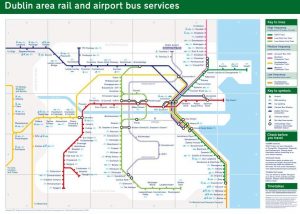The importance of accessibility for people with disabilities should not be lost on either transportation or information. Indeed, the commitment to improving wheelchair accessibility has become a priority in Ireland and around the world.
 Ireland is a very scenic country with rich traditions. It’s home to famous sites like the Cliffs of Moher, Croagh Patrick, and Blarney Castle. The Irish are also known for being friendly people who will welcome you warmly if you visit their homeland. It’s not easy to travel when you’re disabled but, luckily, there are wheelchair-accessible public transportation options in Ireland such as buses, trains, and taxis, but there are also some limitations that need to be addressed to accommodate the needs of those who use wheelchairs or other mobility devices.
Ireland is a very scenic country with rich traditions. It’s home to famous sites like the Cliffs of Moher, Croagh Patrick, and Blarney Castle. The Irish are also known for being friendly people who will welcome you warmly if you visit their homeland. It’s not easy to travel when you’re disabled but, luckily, there are wheelchair-accessible public transportation options in Ireland such as buses, trains, and taxis, but there are also some limitations that need to be addressed to accommodate the needs of those who use wheelchairs or other mobility devices.
Bus Access
If you’re visiting Ireland, or live there and need to get around, you’ll be glad to know that Bus Éireann has several wheelchair-accessible buses that can make your journey a lot easier except in the Dublin Region. This means that there are buses equipped with lifts or ramps to help make getting on and off a little easier for those who use wheelchairs. The bus drivers are always happy to help if you need assistance getting on or off the bus. Riding the bus is a great way to see all of the beautiful scenery Ireland has to offer. There are a few different types of buses in Ireland, but almost all of them have wheelchair lifts or ramps so that people in wheelchairs can travel comfortably. The best part is that there’s no extra charge for using the lift – it’s included in your fare. So if you’re traveling in a wheelchair, there’s no need to worry – Bus Éireann has got you covered.
Irish are very welcoming of handicapped people and they will always go out of their way to help you get where you need to go. This is especially true in Dublin, the capital city of Ireland, which has an extensive network for wheelchair users. The Dublin buses are all wheelchair accessible (with ramps or lifts) and there are even special bus routes with no hills at all. All buses also have low floors to make boarding easy, and drivers are happy to help passengers with any special needs. Plus, there’s no need to worry about being late for your appointment or missing out on the sights — Dublin Bus makes it easy to get around town.
Other cities like Cork, Galway, Limerick, and Waterford also have accessible busses for those who cannot walk long distances. However, some smaller towns may not be as well equipped so it’s best to check local transport options. Disability campaigners have been calling for accessible routes for years, while the National Transport Authority (NTA) has recommended a phased approach to accessibility with inter-urban services not expected to be fully accessible until 2026.
Go-Ahead is a wheelchair accessible bus service that connects Ireland to the UK. This company has a fleet of 133 wheelchair accessible buses, and each one lowers and has one designated wheelchair accessible spot. To board the bus, a ramp slides out from the front door by the driver. If traveling with a power wheelchair or scooter, you are required to use a permit to ensure that it is the correct size for the bus, and thus safe to travel. Permits can be arranged through the Travel Assistance Scheme, where a Travel Assistant will check to see if your scooter fits and will give you all the necessary information you need to travel on the bus. Think about getting a travel pass too, so you can ride on any Ireland Go-Ahead buses. If you would like an accessible version of the timetable, please email customercomment@goaheadireland.ie or call 1850 80 40 71.
To travel between the Dublin Airport and the City Centre, use Ireland’s Aircoach. All these buses are wheelchair accessible and can accommodate one wheelchair per bus. Reservations for wheelchair users are needed.
Luas Tram, Irish Rail, and DART
Many people know about the bus, but other public transportation options include the Irish Rail and the Luas Tram. This can be very helpful for people who need to get somewhere quickly but cannot afford a car or do not have access to one.
Dublin Area Rapid Transit (DART) has a wheelchair-accessible train car for those with mobility issues. This is part of the Dublin Bus company’s continuing effort to provide a safe and reliable public transportation system for all residents in the area. It provides an alternative to driving if you are disabled or elderly because it is too difficult to find parking near your destination. It also offers a more economical option than taxis, which can be expensive depending on where you live and travel in Dublin.
The DART Trains in Dublin are wheelchair accessible, and so are most of the stations. This website gives wheelchair travelers knowledge about what stations are barrier-free. Using wheelchair ramps, staff at the train station can usually assist with the boarding, but depending on station staffing levels, help is not always at hand. Therefore, when traveling with a wheelchair or limited mobility, be sure to make contact in advance of travel to ensure that full support can be provided by emailing access@irishrail.ie or calling (01) 836 6222 (Monday – Friday during business hours.
Taxi Cab Service
 Taxi services are available throughout the country of Ireland and can be arranged by contacting the Information Line at +353 761 064000. These vehicles have ramps that allow access for wheelchair users as well as other passengers who may have difficulty accessing their destination independently.
Taxi services are available throughout the country of Ireland and can be arranged by contacting the Information Line at +353 761 064000. These vehicles have ramps that allow access for wheelchair users as well as other passengers who may have difficulty accessing their destination independently.
Wheelchair Xpress Taxi offers transportation services for wheelchair traveling in the city of Dublin as well as surrounding areas. At Wheelchair Xpress Taxi, travelers will find the largest wheelchair accessible taxis in all of Dublin, each equipped with an electric ramp. These wheelchair accessible taxis can accommodate two wheelchairs and five people all at once. While in South Dublin, people getting around with a wheelchair have the option of using Dublin Wheelchair Taxis.
Ireland continues to improve its services for people with disabilities within its transport system. They are not only providing options on what form of transportation you will use, which includes buses, trains, cars, and more. Terminals around the country are now adding subtitles to their public terminals’ video displays. It is a law in Ireland that video subtitles must be present on public TVs and terminals so people with hearing difficulties can enjoy the show while waiting for their ride or while traveling. Recent advances in technology have made it so that adding subtitles is easier and cheaper than ever before- meaning no one has to miss out on important information just because they can’t hear it. With video editing software becoming more common, it’s easy for operators to add subtitles.
The importance of accessibility for people with disabilities should not be lost on either transportation or information. Indeed, the commitment to improving accessibility has become a priority in Ireland and around the world.














